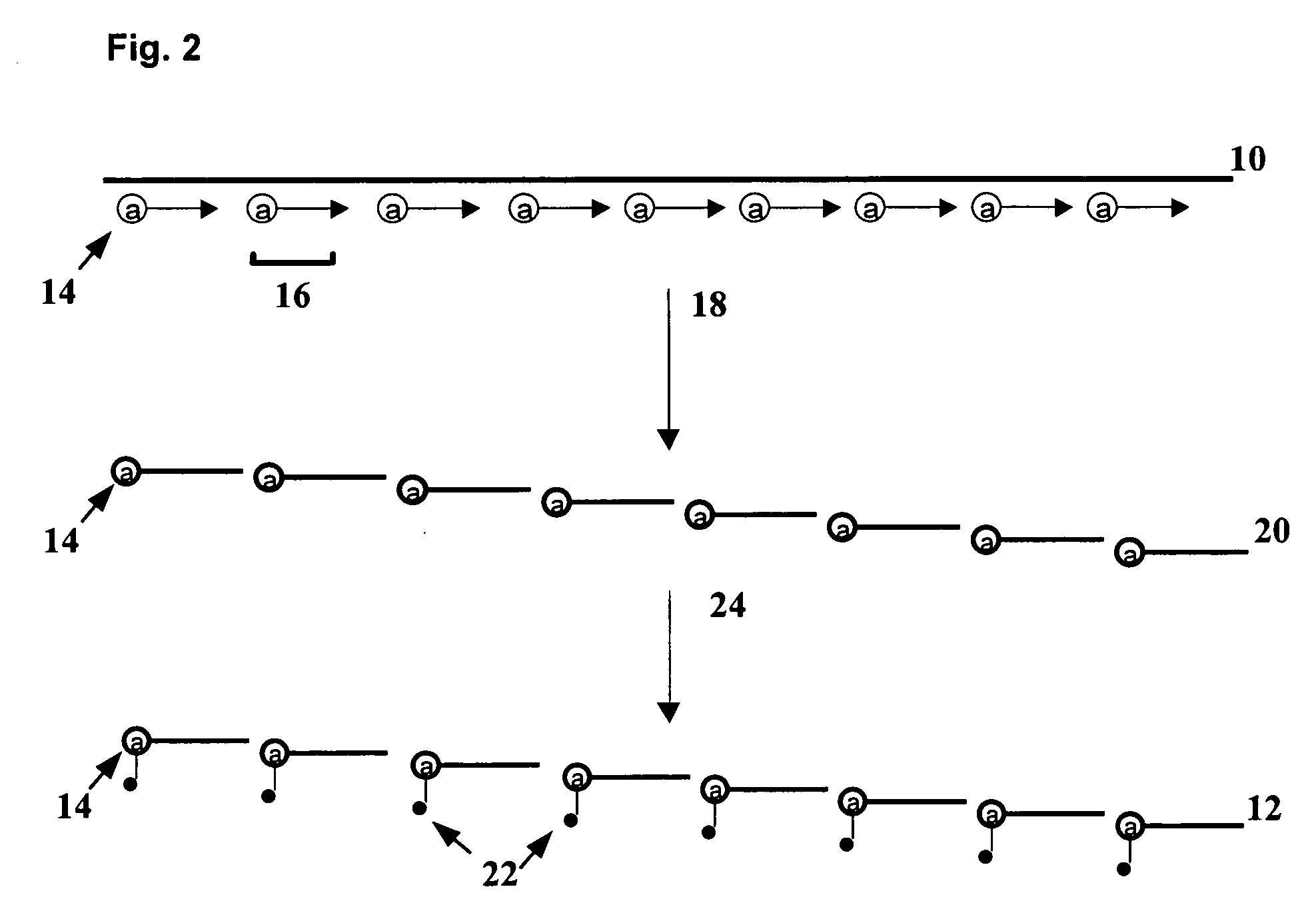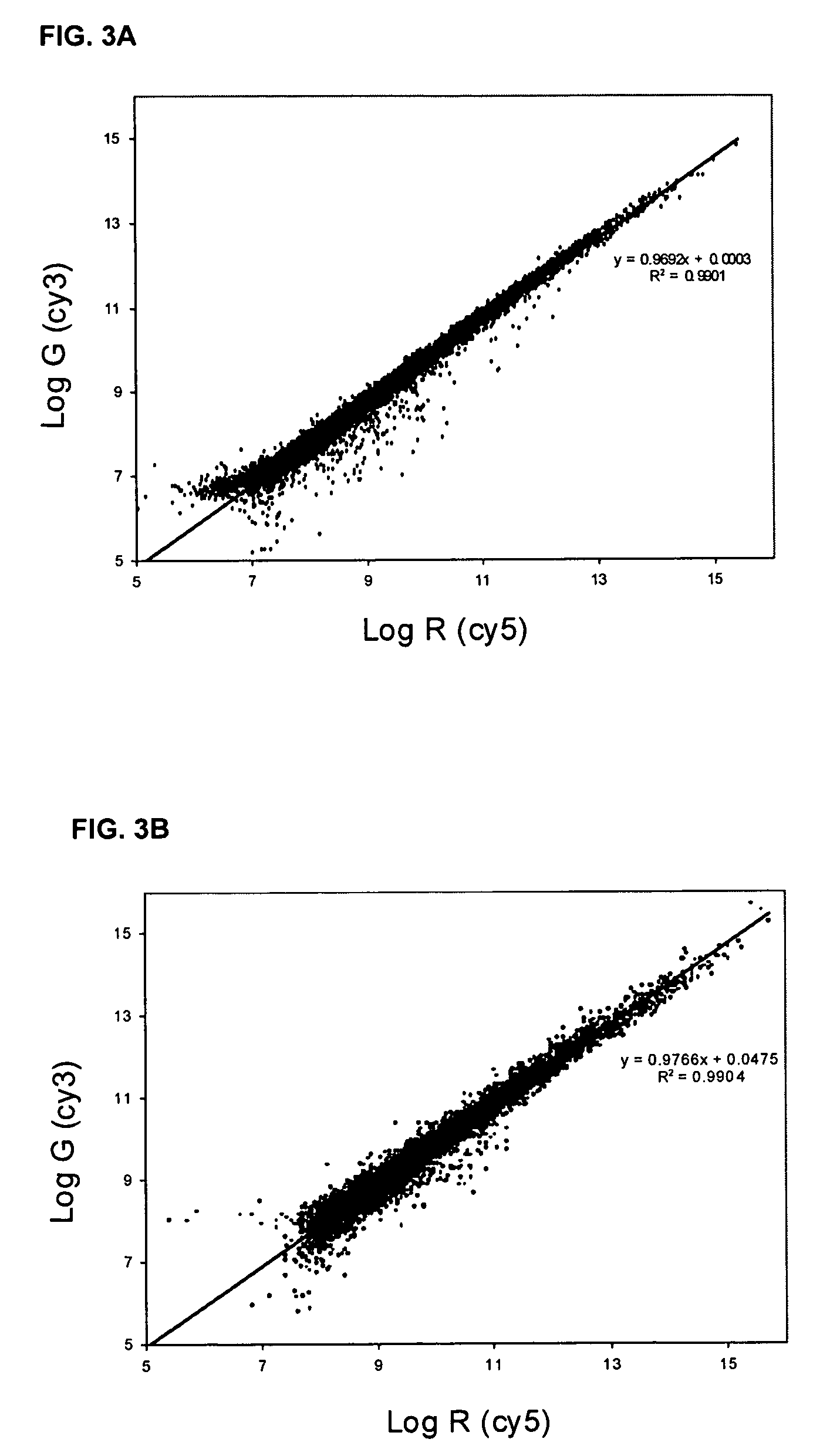Methods of manipulating nucleic acids
a nucleic acid and probe technology, applied in the field of methods of labeling nucleic acid probes, can solve the problems of limiting the efficiency of probe labeling, limiting the efficiency of direct labeling, and limiting the efficiency of indirect labeling methods
- Summary
- Abstract
- Description
- Claims
- Application Information
AI Technical Summary
Problems solved by technology
Method used
Image
Examples
example 1
Production of Primers for cDNA Labeling
[0204] Oligo (dT)12-18 primer (referred to herein as P0) was purchased from GIBCO BRL Life Technologies (Rockville, Md.); it is supplied in a pre-made solution at a concentration of 500 μg / ml.
[0205] Unmodified, random hexamer primer (referred to herein as P1) was purchased from Operon Technologies (New Orleans, La.) and was dissolved in DEPC treated H2O at the concentration of 1 μg / μl.
[0206] Currently, amine-modified nucleotides dT and dC are available from Glen Research (Sterling, Va.). FIG. 1 shows the structures of these amine-modified nucleotides. Using these modified nucleotides, two different amine modified random primers (referred to herein as P2 and P4; Table 2) were synthesized using in vitro chemical synthesis using the phosphoramidite method (Caruthers et al., Chemical synthesis of deoxyoligonucleotides, in Methods Enzymol. 154:287-313, 1987). The oligonucleotides were dissolved in DEPC treated H2O at the concentration of 1 μg / μ1 ...
example 2
Generation of Fluorescent Probe
[0207] This example describes methods for producing labeled cDNA using amine modified primers P2 and P4 and reverse transcription in the presence of aminoallyl dUTP.
Template RNA:
[0208] RNAs from mouse C2 and NIH 3T3 cell lines were isolated using TRIzol reagent from GIBCO BRL Life Technologies (Rockville, Md.) followed by extraction with RNeasy kit from Qiagen (Valencia, Calif.). RNAs from mouse 18-day embryo and liver were also extracted with the combination of TRIzol reagent and RNeasy kit.
Production of cDNA Probe
[0209] Primer (P0, P1, P2, or P4) was annealed to the RNA in the following manner:
[0210] Primer (2 μl), total RNA (0.1-5 μg in 15.5 μl), and RNase inhibitor (1 μl, Promega, Madison, Wis.) were mixed, and the RNA / primer mixture incubated at 70° C. for 10 minutes, then chilled on ice immediately for 10 minutes to encourage annealing of the primers.
[0211] A 17 μl aliquot of the RT mix (6 μl× first strand buffer (provided with SSII RT),...
example 3
Microarray Hybridization
[0222] This example provides a method for analyzing cDNA microarrays using labeled probe produced by the amine modified random primer method, such as that produced by the method of Example 2. The signal generated from microarray hybridization using cDNAs produced using amine-modified random primers is more consistent and more reliable than that obtained with previously known methods that use traditional random or oligo-dT primers.
Microarray
[0223] cDNA microarrays with 10,752 mouse clones were fabricated on glass slides using OmniGrid from GeneMachines (San Carlos, Calif.) using standard techniques.
Hybridization and Analysis
[0224] The labeled cDNA eluate produced in Example 2 was dried in a speed vacuum, and brought up in ddH2O to a final volume of 23 μl. To this was added 4.5 μl of 20×SSC, 2 μl of poly A (10 mg / ml), and 0.6 μl of 10% SDS. The nucleic acids were denatured at 100° C. for 2 minutes, then hybridized, either manually or with the assistance ...
PUM
| Property | Measurement | Unit |
|---|---|---|
| size | aaaaa | aaaaa |
| size | aaaaa | aaaaa |
| size | aaaaa | aaaaa |
Abstract
Description
Claims
Application Information
 Login to view more
Login to view more - R&D Engineer
- R&D Manager
- IP Professional
- Industry Leading Data Capabilities
- Powerful AI technology
- Patent DNA Extraction
Browse by: Latest US Patents, China's latest patents, Technical Efficacy Thesaurus, Application Domain, Technology Topic.
© 2024 PatSnap. All rights reserved.Legal|Privacy policy|Modern Slavery Act Transparency Statement|Sitemap



